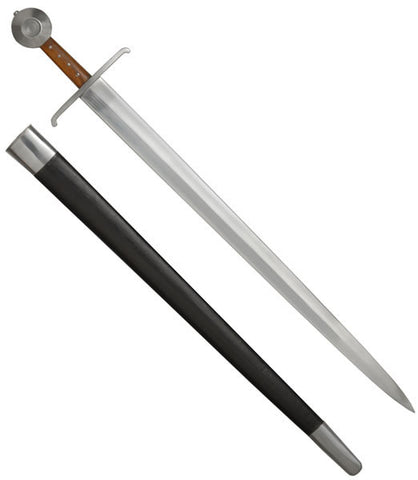Single Handed Medieval Sword - S5736M
Shares :
Ref: S5736M
Single Handed Medieval Sword Museum Quality
Made by John Barnett Single Handed Medieval Sword, Museum Quality
These swords are meticulously hand crafted. They are very well made swords. The tangs are actual full tangs, not the typical rat tail that are found in most decorative swords. The high quality blades are hand forged using EN45 Spring steel to make the blade non brittle and give it a spring like quality that will not warp.
Tempered for strength and finished with sharp edges and a point. This single handed medieval sword design is from around the 13th century onwards. The short hardwood handle makes it surprisingly easy to handle. Crafted in much the same way as swords were made centuries ago, except that the blades are now forged from high-carbon spring steel, a resource unavailable off-the-shelf to the smiths of the old.
The blade has a light polished finish which is closely replicating what the medieval swordsmith was able to achieve. Fittings are polished steel and all of these swords have leather-covered hardwood scabbards.
Key Features: Hand Crafted High Quality Construction Historically accurate EN45 Stainless Steel Specifications: Blade Length. 78cm Blade Width. (Widest). 5cm Grip Length. 10cm Overall Length. 95cm Weight. 1.8kg Weight With Scabbard. 2.1kg The swords of the 13th centuries had not changed overly much, predominately having straight cruciform guards, circular pommels and straight slightly tapering double edged blades.
By the year 1300 defensive body armour had improved quite dramatically, plate armour defences were being combined with chainmail on the arms, torso and legs and improved swords were needed to combat these new armours. Traditionally straight sword guards now begin to be down turned at the ends and blades now develop into very sharp pointed elongated triangular shapes.
These swords had superior handling characteristics as the lack of weight toward the tip allowed for free movement and the sharp point made it easier to connect a thrust with the less well armoured areas of an opponent. It is in this period that we can see swords developing to such an extent that new techniques of sword combat are now possible.


